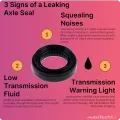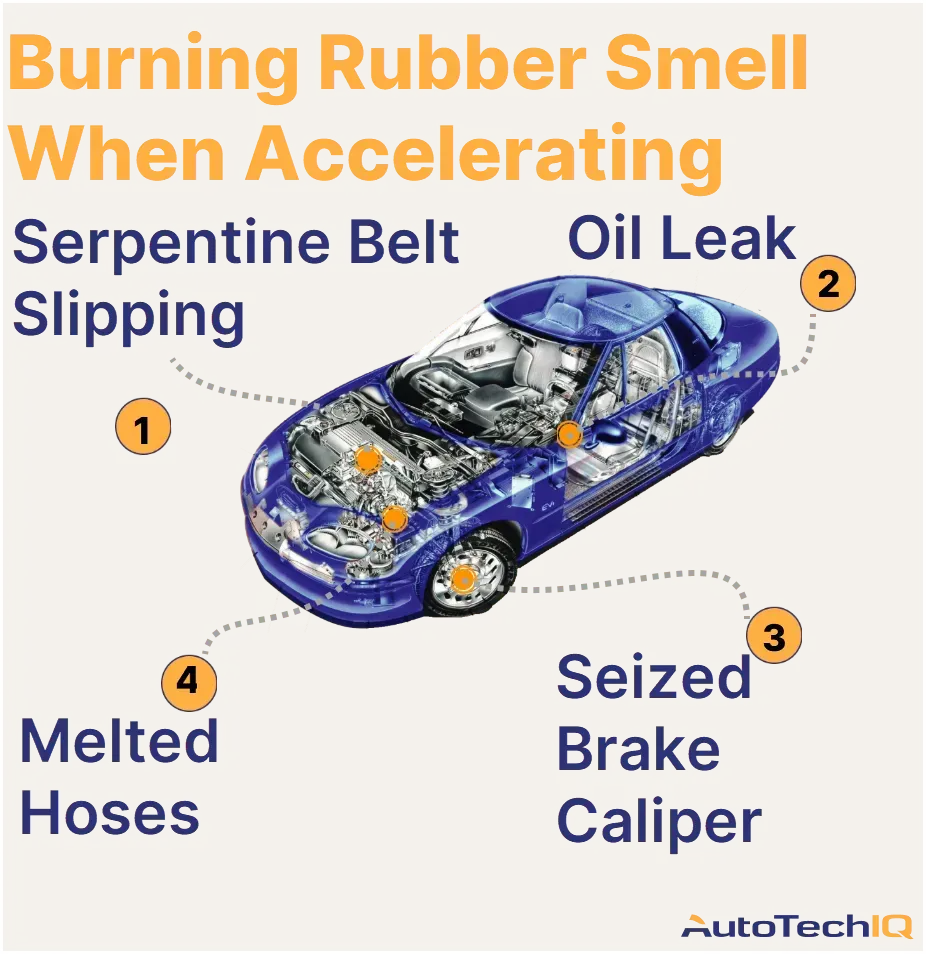

The most common reason for a car smelling like burning rubber when accelerating is a slipping serpentine belt. When the car is running, it prompts the belts under its hood, like the serpentine belt, to rotate and help with power, combustion, etc. So, if one of these belts is slipped out of place, it'll suffer loose movements and rub against hot engine components, melting.
The burning rubber smell when accelerating can also indicate brake problems that generate friction only when the car is driving.
Watch out: A burning rubber smell while driving indicates that something is overheating unexpectedly in the vehicle. This is never a good sign and you should avoid ignoring this, as burning smells in a vehicle can mean serious safety-risking problems.
The vehicle has various rubber parts that are not meant to melt or burn away. Additionally, other systems like the brakes can have a rubbery smell when they overheat and burn. The smell can indicate safety risks as:
-
Fire hazard risks: Car rubber components can endure high levels of heat; if they’re burning off something must be overheating extremely, creating fire risks.
-
Electrical problems: A burning rubber smell might be coming from wiring, insulation, or other electrical components, meaning your vehicle might lose electricity-powered steering, traction, or stability assistance.
-
Brake Issues: Burning smells in cars commonly point to friction on the brake pads, meaning they’re being used excessively or are not functioning properly. Overheated brakes lose effectiveness and could cause a loss of braking power.
-
Health Concerns: A burning rubber can also produce harmful fumes that are hazardous to breathe. Additionally, if the vehicle overheats under the hood, a hot engine might not safely release toxic gases through the exhaust system and exhaust pipe; this can also cause burning engine oil smells.
The most common causes of a burning smell when accelerating
- Slipping serpentine belt: A loose serpentine belt creates friction and heat, leading to a burning rubber smell while driving.
- Seized brake caliper: A seized brake caliper causes constant brake pad contact with the rotor, generating excessive heat and a burning smell.
- Oil leaks: Oil leaking onto hot engine parts, like the exhaust manifold, burns and produces a distinct burning oil odor.
- Melted hoses: Engine or exhaust heat can melt nearby rubber hoses, resulting in a burning rubber smell.
- Faulty tensioner: A faulty belt tensioner allows the serpentine belt to slip or misalign, causing friction and a burning smell.
- Timing cover friction: Friction between the timing cover and the timing belt or chain generates heat, leading to a burning smell.
Frequently Asked Questions
Why does my car smell like burning rubber but only when I go fast?
The burnt rubber smell likely points to overheating caused by increased friction when you accelerate. The culprit could be a worn clutch in manuals overheating from excessive slipping, or a slipping belt on the engine struggling under the extra load. Both can burn and emit that distinct odor.
Does a burnt clutch smell like burning rubber?
A burnt clutch does indeed have a strong burning rubber smell, especially when leaking transmission fluid. The clutch disc contains friction material similar to brake pads, and overheating due to slipping or riding the clutch too long burns this material, releasing that characteristic rubbery odor.
What fluid smells like burning rubber?
No single fluid in your car inherently makes you smell burning rubber. The burning rubber scent usually arises when rubber components like belts or clutch pads overheat and burn due to friction. Leaking fluids like oil or coolant might hit hot engine parts and burn off, creating a similar smell, but it's not the fluid alone. The scent can feel rubbery but mixed with a fuel smell.
Typical fixes to address the cause(s)
-
Water pump replacement: The water pump might fail if it's not receiving power from the serpentine belt, requiring replacement.
-
Tensioner replacement: The serpentine belt is loose because the tensioner failed first. Therefore, the tensioner might need a replacement
-
Test engine vibration: Engine mounts might have loosened up, causing some of the belts to slip out of place. Therefore, the mounts need testing to see if they're properly tight.
-
Test suspension: If the issue is a seized brake caliper, the vehicle's suspension might endure extra vibrations and stress.
-
Timing belt replacement: The timing belt is one of the belts under the vehicle's hoods that are at risk of slipping out of place and melting against hot components, causing the burning rubber smell.
-
Drive shaft repair: Issues related to the drive shaft can indirectly cause such a smell. For example, worn or failing universal joints (U-joints) can lead to excessive vibration, creating friction and causing the smell.
-
Tire replacement: If the issue is a seized brake caliper, the brake system is probably overstressing. This type of stress causes tires to wear excessively, reducing their expectancy.
- Brake caliper replacement: A seized brake caliper might be causing the pads to be constantly engaged, leading to friction and heat, causing a burning smell.
The most common cause: A slipping serpentine belt
The main cause is commonly a slipping serpentine belt. When the belt slips out of place and becomes loose, it'll be prone to rub against hot components in the engine bay and melt. This happens especially while the vehicle is moving.
Since the belt is rubber, it'll be moving and rubbing around the nearest components under the hood while the car drives, burning off and releasing a smell.
What exactly is a serpentine belt?
The serpentine belt, also known as a multi-rib or poly-v belt, is a long, continuous rubber belt. It runs along the grooves of pulleys connected to various components, such as the alternator, power steering pump, air conditioner compressor, and sometimes the water pump.
- Key function: The serpentine belt's main role is to power various accessories and other components that require electricity to work. The components and systems that usually require the serpentine belt are the water pump, the A/C, the radio, the cabin lights, etc.
The belt runs along various pulleys and is close to the alternator, also assisting it in generating power for the vehicle.
Go safe: Given the serpentine belt's importance, it's essential to quickly visit an auto shop to have it looked at if you're feeling a burning rubber smell while accelerating. Moreover, if the serpentine belt isn't at fault, the problem might be related to other vital vehicle systems like the brakes, combustion, etc.
The best action is to visit an auto shop and have a professional mechanic inspect your vehicle through a proper inspection. This type of inspection leads to what's causing the issue and how urgent you need to fix it.
What’s a vehicle inspection? It’s “detective work” on your vehicle, checking its systems to find if anything is preventing the car from working as expected. In this case, mechanics examine different parts of your vehicle to track where the burning smell is coming from and what’s causing it. They’ll also check the condition of components during their inspection, noting which are causing the problem and which got affected by it, recommending to replace them in order of priority.
Transparency example in a serpentine belt service
Let's see an example of a customer visiting an auto shop because they've been noticing a burning rubber smell that starts when driving the car.
In this case, the customer will take the vehicle to an auto shop and request an inspection to investigate the burning rubber smell. The professional responsible for the car first gathers information.
After the customer says the smell only appears while accelerating the car, the mechanic begins testing the vehicle. During many of these tests, they'll replicate the issue and use specific tools to analyze what caused it.
A certified transparent shop registers all the steps taken by the mechanic, including images and videos of the components causing the problems. In this case, the mechanic took pictures of the vehicle's serpentine belt, which slipped out of place; the belt was loose and rubbing against hot components, burning off and releasing the smell.

Finally, the mechanic sends the pictures to the customer, explaining what was causing the rubber smell. The auto shop also quotes the recommended repairs needed to restore the vehicle to a proper running condition while eliminating the customer's concern.
Other news
-
Car is Squealing When Driving

-
What is Preventative Maintenance and What Are The Benefits of it?

-
JobViewIQ - DVI Process Training - Part of the Auto Care Alliance Benefits

-
7 Signs of AC Pulley Issues
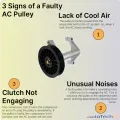
-
7 Signs of Clogged AC Components
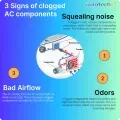
-
How Much Does a Transmission Fluid Change Cost?
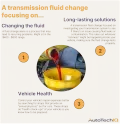
-
7 Signs of a Leaking Axle Seal
